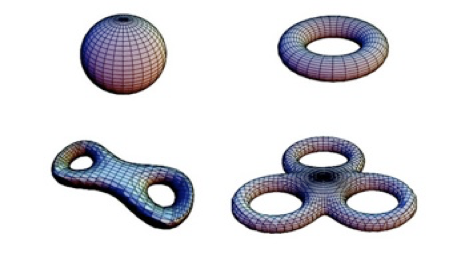Oxford Mathematician Vladimir Markovic talks about his research into intrinsic geometry of Teichmüller Spaces.
"Geometry and topology are concerned with the world of shapes and forms, geography and maps, loops and knots. The main objects of study are finite dimensional manifolds. Two dimensional manifolds are called surfaces. Our purpose is to describe their shapes (geometry) and their form (topology). A closed surface is determined by its genus which is the number of holes it wraps around in space. This classification only takes into account the form of the surface (the topology of the surface) and not its shape (the geometry of the surface).
On the other hand, a closed surface $\Sigma_g$ of genus $g$ can be endowed with many Riemannian metrics (which yield different geometries on $\Sigma_{g}$). A suitable quotient of the collection of all such metrics is called the Moduli space $\mathcal{M}_{g}$ of Riemann surfaces (or simply the Moduli space). The Moduli space is itself a Kähler manifold of dimension $3g-3$. The Teichmüller space $\mathcal{T}_{g}$ is the universal covering of $\mathcal{M}_{g}$.
Theorem 1 (Bers). $\mathcal{T}_g$ is biholomorphic to a bounded domain in $\mathbb{C}^{3g-3+n}$.
The Moduli and Teichmüller space are equipped with the Kobayashi $d_K$, Carathéodory $d_C$, and Teichmüller $d_\mathcal{T}$ intrinsic geometries. The goal is to study these metrics and relate them to each other. One of the most important results in Teichmüller theory is the theorem of Royden that $d_{\mathcal{T}}\equiv d_K$. On the other hand, Yau proved that the $d_{\mathcal{T}}$ and $d_C$ are proportional.
Question 1. Does the identity $d_T \equiv d_K \equiv d_C$ hold on $\mathcal{T}_g$?
Isometries of the hyperbolic plane ${\mathbb{H}}^{2}$ into $\mathcal{T}_{g}$ (with respect to $d_{\mathcal{T}}$) are called Teichmüller discs. Every two points in $\mathcal{T}_{g,n}$ lie on the unique Teichmüller disc (complex geodesic). The identity $d_C\equiv d_{\mathcal{T}}$ holds on a Teichmüller disc if and only if $\mathcal{T}_{g}$ holomorphically retracts onto this disc. The following theorem provides a positive answer to Question 1 in an important special case.
Theorem 2 (Kra,McMullen). The Teichmüller space $\mathcal{T}_{g}$ holomorphically retracts onto every Teichmüller disc determined by a holomorphic quadratic differential with even order zeroes.
In general, the answer turned out to be negative.
Theorem 3 (Markovic) $\mathcal{T}_{g}$ does not holomorphically retract onto at least one Teichmüller disc. In particular, $d_C \neq d_{\mathcal{T}}$ on $\mathcal{T}_{g}$, for every $g\geq 2$.
Furthermore:
Theorem 4 $\mathcal{T}_{g}$ does not holomorphically retract onto a random Teichmüller disc.
In the 80s Siu conjectured that $\mathcal{T}_{g}$ is not biholomorphic to a convex domain in $\mathbb{C}^{3g-3}$. The previous theorem yields the solution to the Siu's conjecture.
Theorem 5 (Markovic). $\mathcal{T}_g$ is not biholomorphic to a convex domain in $\mathbb{C}^{3g−3}$
It remains to classify holomorphic retracts of $\mathcal{T}_g$.
Conjecture $\mathcal{T}_g$ holomorphically retracts onto a Teichmüller disc $\tau^{\varphi}$ if and only if all zeroes of the $\varphi$ are of even order."
Image: surfaces of genus zero, one, two, and three.
Bibliography:
I Kra, the Carathéodory metric on abelian Teichmüller disks, Journal Analyse Math. 40 (1981), 129-143 (1982)
V. Markovic, Carathéodory’s metrics on Teichmüller spaces and L-shaped pillowcases, Duke Math. J. 167 (2018), no. 3, 497-535
C. McMullen, Billiards and Teichmüller curves on Hilbert modular surfaces, Journal Amer. Math. Soc. 16 , no. 4, 857-885 (2003)
We have nearly 200 Oxford Mathematics Case Studies on our website. Take a look.


